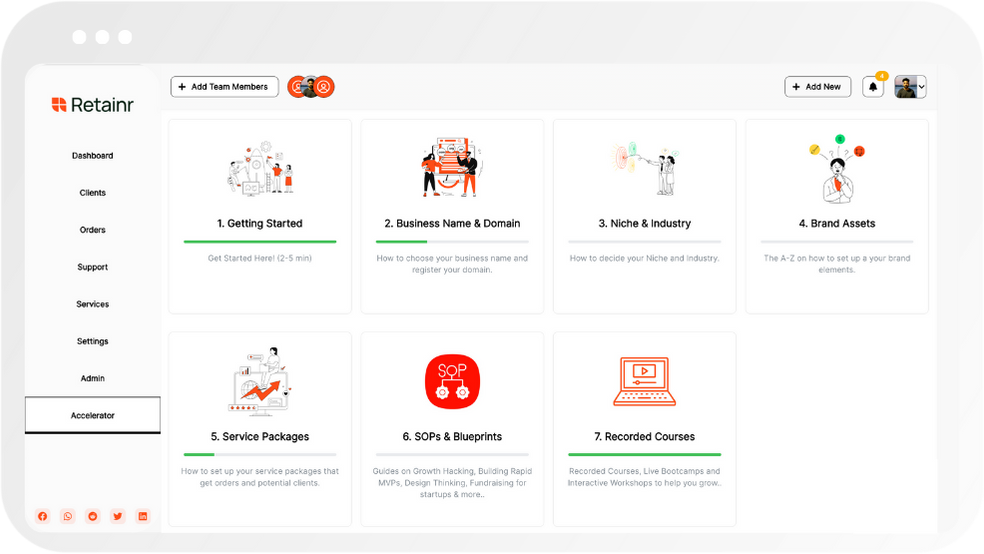
How to Host Productive Online Meetings
Build with Retainr
Sell your products and services, manage clients, orders, payments, automate your client onboarding and management with your own branded web application.
Get Started1. How can one ensure an online meeting is productive?
Optimal Planning and Structuring
To achieve productive online meetings, adequate planning is crucial.
- Setup an Agenda: The first step is to clearly define the meeting’s objectives and share this agenda with all participants prior to the meeting.
- Allocate Time Slots: To ensure every item on the agenda gets the needed attention, it's vital to allocate specific time slots for each topic.
- Prepare Participants: Encourage participants to come prepared by sending resources or pre-read materials in advance. This will help facilitate more in-depth and focused discussions.
Effective Facilitation and Participation
Effective moderation and active participation throughout the meeting are also key.
| Facilitation Techniques | Description |
|---|---|
| Reiterate Objectives | Repeating the main objectives during the meeting ensures everyone remains on the same page. |
| Encourage Participation | Encourage everyone to provide input or ask questions to facilitate a healthy discussion and gather diverse viewpoints. |
| Keep Time | Keep track of time to avoid running over and maintain the productivity of the meeting. |
Utilize Technology for Efficiency
Digital tools can augment the productivity of an online meeting.
- Collaboration Tools: Using real-time collaboration tools (e.g. Google Docs or Trello) allows participants to work together, making the meeting more interactive.
- Audio/Video Software: Depending on the nature of the meeting, the right software (e.g. Zoom, Microsoft Teams, etc.) should be chosen. These tools often come with features like breakout rooms, polling, and screen sharing that could enhance the meeting’s productivity.
- Record & Transcribe: Recording the meeting and generating a transcription could be useful for follow-ups or for those who couldn’t attend the meeting.
2. What are some tips to host a successful online meeting?
Tips for Successful Online Meeting Preparation
Preparation is key towards hosting a successful online meeting. One, ensure you have a stable internet connection to avoid disruptions. Two, familiarize yourself with the meeting's platform beforehand, know the ins and outs, this includes mute/unmute, sharing a screen and engaging chat functions. Three, prepare and share the meeting agenda beforehand, this encourages participants' preparedness..
Conducting the Online Meeting
Another set of tips is essential to the running of the meeting itself. Firstly, maintain professionalism by starting the meeting on time, this shows respect for attendees' time and schedules. Secondly, keep the meeting engaging by allowing, even encouraging, interaction between the participants. Lastly, as the host, always take a leading role in steering the meeting towards its objectives.
| Preparation | Conduction | |
|---|---|---|
| 1 | Stable internet connection | Start on time |
| 2 | Familiarize with platform | Foster Interaction |
| 3 | Prepare and share agenda | Lead the meeting |
Post-meeting Follow-ups
Lastly, effective follow-up is another tip for a successful online meeting. First, share a recording of the meeting if possible, this allows participants to refer back or catch up if they missed something. Second, share meeting minutes promptly, this serves as a formal record of the meeting's proceedings. Thirdly, always invite the meeting participants' feedback, to glean points for improvement in future meetings.
3. What tools or platforms can be used to conduct an online meeting?
Platforms for Online Meetings
There are numerous platforms available today to host online meetings effectively. Some of the popular ones include Zoom, a versatile video conferencing solution that can host up to 1000 participants. It offers a number of features like screen sharing, recording, and breakout rooms. Microsoft Teams is another great choice for businesses that are already using Office 365. It integrates seamlessly with other Microsoft applications and enables file sharing. Google Meet is a part of Google Workspace that provides a simple way to conduct video meetings.
The next set is Webex, a Cisco product used for both small-scale and large-scale meetings. It provides features like virtual backgrounds, and noise removal. GoToMeeting is another online platform known for its robust features like mobile meeting, HD faces video conferencing, and screen sharing. Finally, there's BlueJeans, an easy-to-use platform that ensures secure and productive meetings.
| Platform | No. of Participants | Integration |
|---|---|---|
| Zoom | Up to 1000 | Yes |
| Microsoft Teams | Depends on the plan | Yes |
| Google Meet | Up to 250 | Yes |
| Webex | Depends on the plan | Yes |
| GoToMeeting | Up to 250 | No |
| BlueJeans | Up to 100 | Yes |
Tools for Online Meetings
Regardless of the platform you choose, there are additional tools that can enhance the productivity of your online meetings. Tools like Slack for better communication and coordination, Asana or Trello for task management, and Google Drive or Dropbox for file sharing are often used.
Recording tools such as Camtasia are great to capture meetings for future reference or for those who couldn't attend. Note-taking and collaborative tools like Evernote or Google Docs can be used to jot down and share key points. Lastly, time zone schedulers like World Time Buddy can be really helpful for scheduling meetings with participants in different time zones.
It's important to remember that successful online meetings are not just about using the right tools and platforms, but also about how effectively you can utilize them.
4. How many participants should ideally be in a productive online meeting?
Ideal Number of Participants
The optimal number of participants in a productive online meeting can vary depending on the nature of the meeting. However, some researchers suggest that keeping the number between 5-7 participants is efficient for smaller scale and more intimate discussions. For larger department meetings, anywhere between 12-20 members is considered appropriate.
Factors to Consider
- Meeting Purpose: Depending on the purpose of the meeting one may need fewer or more participants. For instance, brainstorming sessions might benefit from more viewpoints, so a larger number can be advantageous.
- Attendee Roles: If the meeting involves decision making, having all key stakeholders is crucial. However, too many participants can lead to a longer and less focused discussion.
- Interaction Level: If the meeting is a lecture or demonstration, larger numbers aren't an issue as interaction isn't the primary purpose. However, if the meeting encourages active participation, smaller numbers are more effective.
Summary Table
| Participant Range | Meeting Type |
|---|---|
| 5-7 | Small Scale Discussion |
| 12-20 | Department Meeting |
5. How much time should be allotted for an online meeting to be productive?
Estimating the Duration of an Online Meeting
The duration of an online meeting plays a significant role in its productivity. Allocating the right amount of time is crucial to keep the team engaged and focused on the meeting objective without causing burnout. Typically, productive online meetings should be kept to around 30-60 minutes. However, the timeframe can vary depending on the meeting purpose. Here's a general idea:
- Brainstorming sessions: 60-90 minutes. These meetings often require creative thinking that might need a bit more time.
- Project updates or status meetings: 30-45 minutes. These are usually to the point and do not require extensive discussions.
- Training or learning sessions: 60-120 minutes. As these are educational, they could need a longer duration but remember to include regular break periods to maintain concentration levels.
The Importance of Sticking to the Time Limit
To increase productivity, it is important to start and finish meetings on time. Respecting people's time shows professionalism and consideration. Scheduling and adhering to defined time boundaries keep discussions focused, prevents unnecessary small talk and helps to maintain a high attention level among attendees. Therefore, it is recommended to always have a clearly defined agenda with time allotments for each part of the meeting.
Optimizing Time Management for Online Meetings
| Task | Expected Time |
|---|---|
| Assembling Attendees | 5 minutes |
| Introduction | 5 minutes |
| Discussion of Main Topics | 20 minutes |
| Q & A Session | 10 minutes |
| Summary & Closing | 5 minutes |
Remember that every meeting is unique, so these estimated times can be adjusted. However, ensuring that meetings follow this general structure will likely make them more efficient and result in better productivity and time management.
6. How can an online meeting be kept focused and engaging?
Keeping Online Meetings Focused
To ensure that an online meeting stays on track, a few key strategies can be employed. Firstly, it is essential to have a clear and concise agenda distributed to the participants ahead of time. This can often include a timetable for discussions to ensure everyone stays focused.
- Use of agenda: This helps participants know what to expect and prepares them to contribute effectively.
- Allocate specific times for each agenda point: It helps in ensuring that one topic is not disproportionately discussed at the expense of others.
- Maintain control: The meeting leader should rein in participants when they get off topic and keep the discussion focused.
Engaging Participants in Online Meetings
Engagement is crucial in meetings to ensure participants actively contribute and derive value from the discussion. A few ways to achieve this include:
- Interactive tools: Utilize features such as polls and Q/A sessions for active participation.
- Show appreciation: Acknowledge and appreciate participants' input to encourage participation.
- Encourage video: While it's not always practical, encouraging participants to turn on their video can increase engagement and connection among the group.
Summary of Effective Online Meeting Strategies
To effectively host online meetings, you should focus on keeping the meeting streamlined and engaging at all times. Below is a table summarizing these approaches for easy reference:
| Focus Area | Strategies |
|---|---|
| Keeping Meeting Focused | Use of agenda, allocate specific times for each point, maintain control |
| Increasing Engagement | Use of interactive tools, show appreciation, encourage video |
7. How can one manage time zones when hosting an international online meeting?
Understanding Time Zones
When planning an international meeting, it's crucial to consider the various time zones of all participants. A good starting point is identifying the time zones of every participant, then finding a common time suitable for everyone. Tools like Timezone.io or WorldTimeBuddy can provide an overview of the global time differences.
- Always state the meeting time in Coordinated Universal Time (UTC) to avoid confusion.
- Record the meeting for those who can't attend due to inconvenient timing.
- Try to rotate meeting times if you frequently host international meetings to ensure no one is always inconvenienced.
Using Scheduling Tools
Another effective strategy for managing time zones when organizing an online meeting is the use of scheduling tools. Scheduling tools like Calendly or Doodle can automatically detect and convert time zones for ease of scheduling. Incorporate these tools into your planning process to streamline your workflow.
| Scheduling Tool | Main Features |
|---|---|
| Calendly | Automated time zone conversion, integration with popular calendars, elegant interface |
| Doodle | Polling feature for easy scheduling, time zone support, mobile app for on-the-go planning |
Clear Communication
Ensure clear communication about the meeting timing. It's your responsibility as a host to give all participants ample notice about the scheduled timing and any changes. Apart from the scheduled meeting invite, send an individual email with the UTC time, highlighting the time conversion for their time zone.
- Include a link to a time zone converter in the meeting invite for easy reference.
- Send reminder emails a day or a few hours before the meeting.
- Specify the expected meeting duration to help attendees manage their time.
8. What should be prepared before hosting an online meeting?
Preparation Steps Before an Online Meeting
Before hosting an online meeting, several vital steps should be taken to ensure a productive and seamless session - setting clear agendas, technical readiness, and meeting facilitation plan.
- Setting Clear Agendas: Create a detailed agenda for the meeting. This should include the topics for discussion, the order of presentation, and who is responsible for which sections. The agenda should be distributed to all participants prior to the meeting.
- Technical Readiness: Test all the technical elements of the online meeting platform. This can involve checking video and audio quality, testing sharing screen capability, preparing polls or interactive elements, and ensuring a reliable internet connection.
- Meeting Facilitation Plan: Design a plan to facilitate communication. Determine who will moderate the meeting, how questions will be addressed, and how you will ensure all voices are heard. It's also important to plan for breaks if the meeting is supposed to last for more than an hour.
Important Items to Prepare
Several items also need to be prepared to conduct a smooth online meeting such as meeting materials, backup plans, and inviting participants rightly.
| Item | Description |
|---|---|
| Meeting Materials | All presentation materials, including slides, data, reports, or visual aids, should be ready in their final forms. If possible, send these out to participants ahead of time so they can review them and prepare questions. |
| Backup Plans | Have alternatives ready if there are technical difficulties. This can include having a different presentation method, a secondary meeting platform, or another time set aside. |
| Inviting Participants | Send out the meeting invites well in advance. Make sure to include the date, time, link to join, agenda, and any materials that participants should review. Consider utilizing calendar invites or setting reminders. |
Beyond Basics: Pre-meeting Engagement
Engaging participants before the meeting is key to fostering participation during the meeting. Encourage participants to bring their ideas and questions to the table. You could even host a pre-meeting chat or forum for participants to discuss the upcoming topics and bring up any pre-meeting thoughts.
9. What are some common technical issues in online meetings and how can they be avoided?
Common Technical Issues in Online Meetings
Online meetings can often be subject to a variety of technical issues that can disrupt the productivity and flow of the discussion. Some common technical problems include:
- Connection troubles: Issues such as connectivity loss, unstable internet, device connectivity can often impede the smooth conduct of the meeting.
- Poor audio or video quality: Audio glitches or video freezes can lead to miscommunication and loss of valuable information.
- Software Malfunctions: The meeting software may fail, freeze, or experience glitches, disrupting the meeting flow.
Avoiding Technical Issues in Online Meetings
To minimize the chances of encountering such difficulties, follow these guidelines:
- Run a technical check before the meeting: Test your device, software, and internet quality before the meeting to detect and address any issues.
- Use reliable meeting technology: Use trusted and reliable online conferencing software. Read reviews and check the features before choosing one for conducting meetings.
- Equip yourself with backup options: Always have a backup device and network option available should any kind of technical malfunction occur.
Technical Issues and Solutions Table
| Technical Issues | Solutions |
|---|---|
| Connection Troubles | Perform a connection check, Install network boosters, have a backup network option. |
| Poor audio or video quality | Check hardware, Close unnecessary applications, Use external speakers or headphones. |
| Software Malfunctions | Keep software updated, Choose reliable platforms, Have alternate software on standby. |
10. How to manage or handle interruptions and distractions during an online meeting?
Handling Interruptions during the Online Meeting
Interruptions and distractions are common in online meetings and can lead to inefficiency and frustration. Here are a few ways you can manage them:
- Set Rules: Define the rules at the beginning of the meeting to minimize interruptions. This could include asking participants to keep their microphones muted until it's their turn to talk.
- Use a Moderator: Assign a moderator who will monitor the chatbox and mute any disruptive participants.
- Be Patient: Patience is crucial when dealing with interruptions and distractions. If someone interrupts, allow them to finish before addressing the issue respectfully.
Dealing with Distractions in Online Meetings
Different types of distractions can come up during online meetings. Here are a few methods of handling them:
| Distractions | Methods to handle |
|---|---|
| Background noise | Request participants to mute their microphones when not speaking and use a quiet environment. |
| Technical problems | Provide technical support or guides for attendees and encourage rehearsal or testing setup beforehand. |
| Multitasking participants | Keep the meeting engaging and remind participants of the importance of full attention. |
Distraction Free Online Meetings
Distractions are inevitable in some cases. However, by employing the right strategies, you can create an environment that encourages productive online meetings. Remember, the goal is to make the meeting as seamless and engaging as possible. This way, interruptions and distractions can be minimized, ensuring that the team's focus and productivity remain high.
Conclusion
Efficient Strategies for Hosting Productive Online Meetings
Today's workplace has become more digital. Online meetings are now more popular, which has made hosting productive and efficient meetings a skillset needed by every leader. This blog provides essential tips on how you can host productive and efficient online meetings.
Preparation Before the Meeting
Proper preparation before a meeting reduces the risk of technical glitches that could hamper productive discussions. Make sure that all participants have the necessary meeting link and the correct time.
Take Advantage of Technology
Online meetings can be optimized with the use of technology. One of the most effective tools for hosting online meetings is www.retainr.io. This whitelabel software not only helps you manage clients, orders, and payments with your own branded app but also simplifies the process of hosting and organizing online meetings.
A Clear Agenda and Proper Time Management
Craft a clear and concise agenda and adhere strictly to your meeting's timing. Your aim should be to find a balance that ensures all items on the agenda are addressed, and the meeting does not run over time.
Encourage Participation and Engagement
Productive meetings require active participation from all the attendees. Encourage everyone to share their thoughts and ask questions to stimulate valuable discussions.
Experience seamless online meetings with Retainr.io. You can manage your clients and their orders seamlessly and ensure everyone stays on the same page. Don’t just host a meeting; host productive meetings perfectly designed for efficiency and engagement. Visit the Retainr.io website to learn more.
Boost Your Agency Growth
with Retainr Accelerator
Uncover secrets, strategies, and exclusive blueprints to take your agency's growth to the next level — from marketing insights to effective presentations and leveraging technology.

SOPs, Cheatsheets & Blueprints
Leverage 50+ SOPs (valued over $10K) offering practical guides, scripts, tools, hacks, templates, and cheat sheets to fast-track your startup's growth.
Connect with fellow entrepreneurs, share experiences, and get expert insights within our exclusive Facebook community.
.jpg)

Join a thriving community of growth hackers. Network, collaborate, and learn from like-minded entrepreneurs on a lifelong journey to success.

Gain expertise with recorded Courses, Live Bootcamps and interactive Workshops on topics like growth hacking, copywriting, no-code funnel building, performance marketing and more, taught by seasoned coaches & industry experts.

.jpg)

.jpeg)


